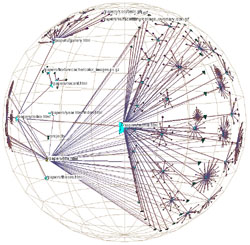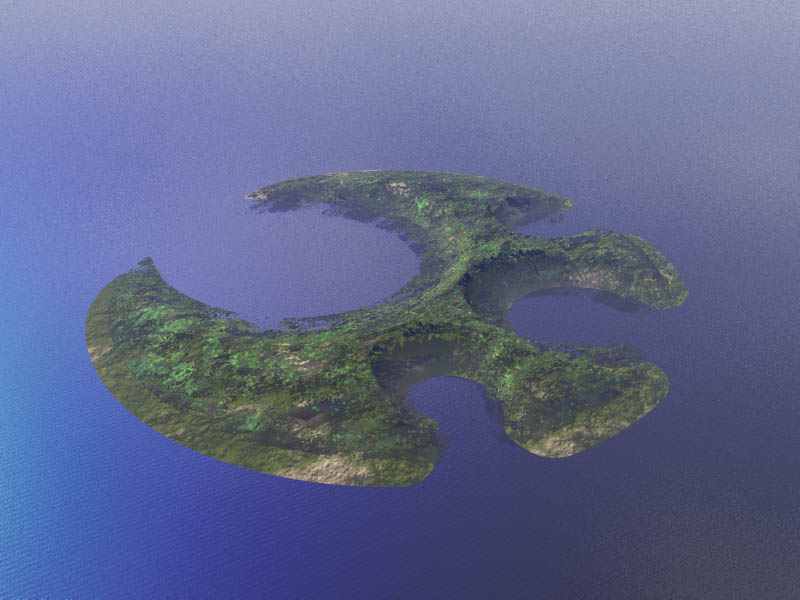
Technology in 2034 has developed into technological ecologies. Not only are many devices biological or have biological parts, but even traditional machines interact with each other, exchanging information such as position, type and ownership data, linking into informal networks to maximise efficiency (such as cars travelling the same way automatically forming convoys or computers distributing jobs evenly). These ecologies not only provide a very efficient service, but are also more resistant to the crashes that plagued 20th century technology. Instead of whole system breaking down due to a small component failing, the system adapts and tries to circumvent the trouble. The price is that many devices connected into ecologies exhibit slightly quirky behaviour, as they invisibly negotiate with other devices about how they should act. Another, more socioeconomical problem is that ecotech tends to work badly on its own - you have to own more of it and live in a smart environment to get the full potential.
Space development has been spotty. After the unmanned surveys of the solar system in the 00's, the funding for space exploration largely vanished. Most space activities the last decades have dealt with launching satellites and maintaining them. The Earth is now surrounded by dense satellite constellations of communication satellites, positioning systems and high-resolution imaging systems. Buying a satelite scan over an area is relatively cheap, and can reveal details down to the decimeter range.
Major launchsites include Cape Canaveral (now run by NASA Corporation), French Guyana (European Space Network), Nauru (N-Space) and Pulau Gebe (Moluccan Satelite Launch Inc), although sea-based launch systems from mobile artificial islands are predicted to overtake them in the near future.
The amount of orbital junk has also increased to a worrying extent, and despite the continual warnings and proposals from Space-TAG, insurance companies and space networks no satisfactory solution has been found yet.
If the 90's was the decade people discovered the Net, the 00's was the decade when it became powerful, the 10's the decade when it became useful and the 20's the decade when it became so everyday nobody noticed it any more. All modern equipment has chips containing independent onboard computers and positioning software. Literally every soda bottle has its own website advertising its contents, holding its individual history and properties and links to further references. A modern home or office is filled with ubiquitious computers and smart devices making information available anywhere, anytime. Satelite-based net access exists everywhere and is quite affordable.
Most computers use voice or touch interfaces, displaying their results through audio or on a visual surface. Most internationalists wear contact lenses enabling them to see augmented reality generated by their clothing computers.
As chip technology reached the limits in the late 10's and early 20's, people moved on to distributed computing and neurocomputing. There were no real need for faster, smaller individual computers in most everyday applications (full photorealism immersive VR games, net videophones or semantics checking word processors only need a finite amount of computer power and bandwidth) so people began to rely on networks instead. For special heavy computations supercomputers, netwhales, dedicated database crunchers or dreamblobs are used.
Encryption
The digital economy is based on cryptography. Secure codes and protocols underlie the international economy and the trillions of transactions that occur every hour, and could well be said to be the weapon that the internationalists used to wrest control from the nations in the 10's. Over the last four decades cryptography has gone from a small mathematical discipline to a megabusiness and major academic field. Using cryptography it is now possible to communicate and trade untraceably and anonymously over the net, place information in secret drop-off points, authenticate documents with no chance of forgery, perform secure and secret voting virtually and much more. Terminology such as cocktail-party servers, nyms, zero knowlede, flings and opentraps are commonplace.
Although encryption can in principle be made uncrackable (especially if quantum encryption is used), in practice mistakes will be made that can be exploited. Any system is as strong as its weakest link, and if the codes cannot be hacked then users or their programs can be subverted. Computer security is another megabusiness, keeping millions of people busy trying to patch potential security holes and detect intrusion attempts.
Neuroprocessors
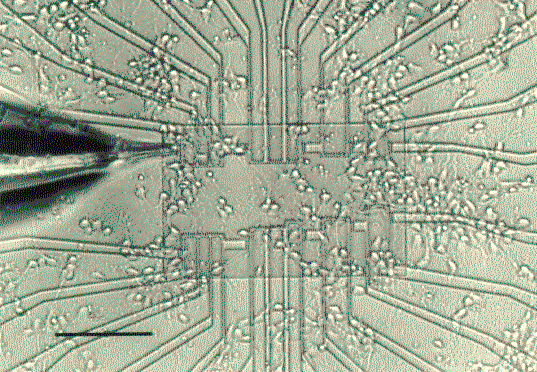
Using real neurons as computing element became possible after the revolutions in biotechnology and neuroscience. It became possible to not just culture neurons but to make them grow into predictable patterns, or to use the genetic programs forming useful brain areas. Neurocomputers are grown from undifferentiated animal cells connected to electronic interfaces. Once the cells have formed a neural net, it is trained for its purpose and delivered inside a protective shell containint a miniaturized life support system. By making the cells immortal and adding a limited neurogenes the neuroprocessor can be made to last indefinitely as long as they do not sustain damage or run out of their nutrients.
They have the advantage over normal processors because they can exploit massive parallelism and learn well, as well as exploiting the clever tricks used in animal brains. The most advanced neuroprocessors mimick the brains of small mammals, and often exhibit designed personalities. The most common use is as controllers for robots and drones, or integrated in other biotech.
Netwhales are datacombing neuroprocessors, finding patterns in the flow of information on the net. They can learn and discover interesting connections in an intelligent manner. Controlling them and getting them to find anything useful is still an art, but many of the most interesting and surprising new discoveries in science, economics or ecology over the last years have been made by human-netwhale teams.
Simulation neuroprocessors, "Dreamblobs", are used to learn a domain (such as the weather, the stock market or brain activity) and can then simulate it or act as a predictor. Dreamblobs can be cultured to learn almost any kind of domain, although the usability varies. It has become popular to link up dreamblobs to Net based virtualities to give them a more complex "realism" or add surprising and charming quirks to characters.
Controller nets are used in many bioengineered animals. A radio-interfaced neuroprocessor is implanted in the cranial cavity, connecting to the brain in a predetermined manner. Usually they act as controllers for the animals, allowing the owners to control their behaviour and receive fairly blurry sensory information. Similar neuroprocessors have been used for rehabilitation of paralysis or brain injuries in humans. While a few radicals have implanted neurointerfaces into themselves to extend their capacity the option is still regarded as more costly than beneficial, even if there is an intense interest in the possibility of deep brain-computer interfacing.
Smart materials are everywhere, ranging from solar collector foil over adaptive beams with embedded microcontrollers that makes the beam adapt to loads to self-repairing wood- or coral-like living materials.
Gel muscles are common in many devices: a synthetic gel changes shape depending on electrical signals, making it possible to make efficient moving objects.
Self-assembly is common for microdevices: when placed in contact with the right environment they spontaneously shape themselves to fit it and each other. This is often combined with biobots and other sophisticated methods to construct three-dimensional integrated objects.
Living materials are common. They are usually plant-based, having textures not unlike wood or ivory. Since they are self-repairing, adaptable and often can provide control over microclimate indoors they are especially popular as building materials. Bioplastics are formed by special cultures of genetically modified organisms, just as versatile as classic chemical plastics but much cheaper and easily integrated with microtechnology or smart materials.
Modern transports range from transorbital spaceplanes able to reach anywhere in the world within 40 minutes to cars built mainly of bamboo and fuelled by tree sap. In general they are quite similar to the vehicles of the turn of the century, but in general much smarter (usually equipped with collision detection, traffic management and similar features) and energy efficient.
Modern materials enable limited "shapeshifting" in advanced vehicles. Modern military helicopters for example can shift between helicopter and aeroplane configurations, and advanced boats often employ adaptable hulls.
Mesicopters are centimeter-sized devices able to fly around with cameras or small manipulators, the most common form of independent drones.
Airsats are becoming more and more popular alternatives to the expensive and damage-prone satellites. They are solar-powered unmanned aeroplanes circulating over an area 24 hours a day for months at a time. They can act as communications links, surveillance bases or other information services. Currently many supply major cities with the ultra-high mobile bandwidth communications they demand.
The efforts to deal with the greenhouse effect led to a slowing of fossil fuel usage in the 00's and 10's, the construction of more nuclear reactors and an overall increase in energy efficiency. After the climate change began fossil fuel usage has increased, but due to the price, environmental regulations and modern efficient technology the usage is still roughly on par with the 2010 usage.
Solar power is popular in the tropics (the lower temperatures has not affected the energy input much, other than changing the cloud cover). Artificial islands usually employ OTEC (Oceanic Thermal Energy Conversion), exploiting the energy difference between the warm surface water and cold deep sea water.
Fuel cells have developed to become the energy source of choice for vehicles and buildings worldwide. Traditional fuel cells use catalysts to convert fuels to electricity, while the more modern biocells employ an organic matrix with designed enzymes. Varieties can be adapted to run on nearly anything - alcohol, sugar, gasoline or fat just to name a few possible fuels.
Biopower, energy directly from biological devices such as modified plants that either produce electricity or fuel, is steadily becoming more common. However, most biotech requires nutrients too (usually provided by standardised nutrient solutions). A common form of biopower is plantations of modified plants providing nutrients directly to biotech; this is used in artificial islands and biotech buildings.
Looking back on it all now from the rising bamboo spires of Newer York, I realize it was the architecture of the past that was weird and far-fetched. Those old, greenhouse-gas-spewing buildings ... full of fragmented technology ... deaf-and-blind stand-alone boxes that didn't even have operating systems!
Newer York, New York, Michael McDonough and Bruce Sterling
Architecture has developed to encompass the new smart materials and technological ecologies. Modern buildings (almost exclusively found in the International Zone) are designed from the start to be efficient, pleasant and smart.
The original biobuildings were deliberately trying to look natural or organic, streamlined shapes bulging with apartments, rootlike entrance hallways, sculpted cliffs or sails. The new materialist buildings instead go for invisibility; the ideal house should be impossible to distinguish from the surroundings - partially subterranean terraces or stepped pyramids with walls covered with greenery making them look like hills. In both cases outside plants, especially modified bamboo and trees are common. They are not just decorations, but actually fullfill a variety of functions in nutrient production, heat exchange, humidity adjustment, management of the local ecosystem and regulate light levels.
Smart guns: Modern weapons are usually equipped with plenty of helpful electronics, including digital sights and computer links to the owner's wearable. The most modern guns have image processing software, helping to shoot at the target and avoid friendlies.
C3I systems (Command, Control, Communications, Intelligence) are the mainstay of all but the most primitive armies. By linking smart guns with wearables and information integration back at HQ soldiers (and police, firemen or guerillas) can coordinate their actions, avoid some of the fog of war, shoot at invisible targets, direct drones and do many tricks that would have been unthinkable just 30 years ago.
Bamboo shots: modern electronics makes it possible to build cheap cruise missiles. During the Chines Civil War standard GPS devices connected to an ordinary computer running a downloaded control program were used to control crude but very cheap missiles (some even using wings held by bamboo stems). Bamboo shots have since then been used in other conflicts and terrorism.
Tranq blobs are gel rounds containing a strong tranquilizer acting through the skin. They are standard in many police arsenals of nonlethal weapons.
Drones
Since losing soldiers behind enemy lines or in any form of conflict had become a media nightmare for the western powers in the 90's, unmanned or remote-controlled vehicles and weapons became more and more used. The first were mainly drone aircraft for surveillance and monitoring, but in the middle 00's NATO commissioned remote-controlled weapon carriers and in the 10's the first semi-autonomous drones. Today robotic weaponry, usually controlled by neurocomputers, is the mainstay of technologically advanced armies.
A typical drone is a small robot, usually flying or rolling on tracks, equipped with limited autonomy and connected to a C3I system which directs it. Modern drones employ advanced sensors enabling them to see through walls, bioplastic armor and highly efficient fuel cells enabling them many hours of active time. There exists all sorts of add-ons, ranging from solar cells to missiles. The brain is either electronic or neural, and doesn't have to be inside the drone.
Mosquito drones: Small spy drones, the size of a mosquito and with roughly the same speed. Can relay images from its sensors, drop off microbugs and programmed bacteria or act as communications links.
Saucer drones: Standard form of flying drones. A disk with four high velocity fans that can fly, hover and navigate small spaces. Small drones are used for surveillance, larger ones can be equipped with weapons.
Minitanks: Unmanned tank drones. Fairly rare, but able to combine agility with armor and heavy weaponry.
Underwater drones: Relatives to the saucer drones, able to swim underwater and act as sentries, defense or maintenance. Especially used on the bioislands.
Guanzhou Industries Phoenix
A common saucer drone manufactured in Canton, typical of the mid-tech end of the drone spectrum. It is based on biomaterials, although it is not alive. It is controlled by a command console housing a number of linked neurocomputers to control a squad of drones.
Sty *** Per ** Dex (swift) ****** Int * Sta *** Wit (lightening quick) **** Alertness *** Dodge *** Firearms *** Stealth *** Damage: 0, 0, 0, -1, -1, -2, -2, -5, -5, destroyed
Weapon: usually a 0.30 Calibre Machine Gun (difficulty: 6 damage: 6 range: 800 y rate: 21 Capacity: 100)
The shell acts as six dice of armour, and can change colour for camouflage purposes. It has visible light and infrared vision. By adding the right software to the C3I it can do indirect fire at targets seen by other drones or cameras, or trace fire lines.
The drone acts on its initiative level, but the handler acts on his own. Unless given new orders the drone will continue running its programming, which is usually preset modules such as "Scout and report", "Kill all selected targets within area", "Follow vehicle" etc.
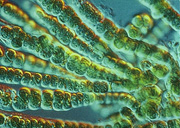
The world of 2034 is dominated by the advances made in biotechnology. While information technology led to the dramatic transformation from industrial society to an information society, biotechnology is now causing the transition away from information to biology. Without biotechnology the world would not be able to sustainable feed itself or handle the epidemics that regularly emerge. More subtly, it is changing humanity's relationship with nature: instead of seeing nature and technology as opposite ends, by necessity antagonistic, they are becoming a single field. In this new paradigm there is no difference between natural or man-made, both emerge as biological processes and are judged on their own merits. Humans are seen not as intruders or stewards of nature, but as active evolutionary participants inventing new possibilities for the ecosystem. Needless to say, this new view is not universally accepted or understood by everyone, and there are many groups especially among the nationalists and conservatives that denounce biotechnology as blasphemous hubris.
While the major advances have been the complete mapping of many genomes and the methods of efficiently model and perform genetic modifications, some other developments have been crucial for making biotechnology into what it is. One major milestone was the 2015 development of "locked ecosystems", a way of keeping modified organisms from spreading into the wild by giving them an interlocking set of evolutionary advantages and disadvantages that ensures that they cannot survive outside the intended ecosystem and that outside organisms have a hard time colonising it. This, combined with good methods of creating biochemical dependencies, made the free use of genetically modified organisms much more acceptable and laid the foundation for the biotech boom of the 20's.
A more divisive issue was patents in biotechnology. The issue was never clearly resolved and to this date causes considerable friction between nations, corporations and internationalists. The common view is that biotech patents are as unenforcable as music copyrights, and that companies should rely on speed of marketing rather than patents to earn from their developments.
All sorts of bioengineered animals exist, ranging from the eternally young and cute Metaneko kitten to programmed bacteria for engineering to cows acting as ecological maintenance machines. In agriculture most crops are modified in one way or another to stand pests, the climate change, produce extra nutrients and vitamins or produce extra substances so that waste products from food production can be used more efficiently in other ways.
Tupilaks are composite creatures, built from cultured organs or limbs. So far they have not seen much use outside specialised applications, but building animals from modular parts are likely more cost-effective than engineering entirely new species.
The most widely used bioengineered organisms are biobots, bacteria modified to act out specific orders. They are used for nanotechnology, production, monitoring, medicine and much more. They are made by designing a biochemical reaction network that reacts in a suitable way to outside stimuli such as chemicals or light, and connecting it to various extra genes controlling the behaviour of the bacteria or the production of other chemicals. This way the bacteria can be made to perform quite elaborate tasks, and often several kinds of bacteria are used together.
Designer phages is another major biotech field. They are designer viruses that infect bacteria. The main use is to get rid of biobots or infectious bacteria, but they can also be used for reprogramming biobots. Some biobots actually act as factories for phages, and can be used to quickly produce large amounts of them.
Nanotechnology is expected within 10 years. Self-assembling micromachines, biobots, advanced organic molecules and direct control over atoms are converging on the construction of general machines on the nanoscale. Once this is achieved, the world economy will be transformed yet again. Internationalist investors can hardly wait, although many nationalists are very concerned.
The phage vats
After the Beryllium Affair in 2029, NERD developed plans for a system for spreading defensive biobots worldwide. Special microfactories produce bacteriophages and biobots intended to detect and kill identified dangerous microorganisms. These "phage vats" (or "lymph nodes" as they are called in the nanotech defense business) are placed in major cities, thoroughfares and airports, connected to NERD and I-TAG monitoring systems. The vision is to be able to quickly detect outbreaks of disease or malign biobots, and blanket large areas with defensive orgs manufactured from downloaded specifications. So far the vats only cover some areas, mainly in the International Zone.
Bionics
Implanted artificial organs, tissues or cells is currently the mainstay of medicine to deal with many diseases. Autografts, cells cultured from the patient's own body and differentiated to a suitable state, are injected to speed repair or replace dead tissue (for example in brain damage or to keep the immune system young and agile).
Enhancing use of artificial organs has not yet become widespread (despite the assurances of many industry analysts that it will be) since most functions can be performed in easier ways or using external technology or symbiotes without the hassle.
Drugs
Disinhibitors are non toxic, non addictive drugs that produce a mild sensation of well being and increase the effort required for considered thought. The drugs are self limiting, impossible to overdose and so mild that in many areas of the international zone they are legal and used as a social alternative to alcohol.
Life extension
People who follow a scientific regimen and have access to normal healthcare have an average lifespan of 100 years; most people live for 70-90 years on average. Using modern medicine lifespan can be extended at least up to 120, although modern gene therapy may very well break the original barriers to human lifespan. Many internationalists fully consider themselves to be the first immortal generation.
Human Germline Genetic Engineering
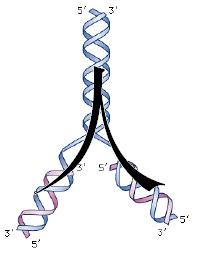
Modifying the human germline has the potential to change the child totally. So far, despite fears to the contrary, the changes have been fairly conservative. Parents among the internationalists and a few rich nationalists remove heritable diseases and add some positive genes linked with health, intelligence, long life and a good appearance. Usually they are added to easily edited and controlled "technochromosomes", extra artificial chromosomes that are not transmitted in reproduction. While more radical changes are possible few parents risk them on their children, instead preferring well tried standard genes. This has not, as some doomsayers predicted, led to standardisation of humans - there are far too many genes for that and people with similar genes still develop radically different - but there are very few humans diverging much from the traditional norm yet. Transhumanists of course expect this to change soon, but people are more conservative about the health of their children than many give them credit for.
Enhancing gene therapy of adults is available in some regions. Mostly it is used to improve strength and slow ageing, although there are therapies to improve brain plasticity.
Symbiotes
Designer microfloras have been used since the 00's, at first mainly to help digestion by having the right symbiontic bacteria in the gut, later also "friendly skin bacteria". In 2034 many people not only monitor their microfloras regularly (either with home self tests or through symbiont therapists) but apply engineered microorganisms to keep themselves healthy, smell well and gain extended abilities. Typical symbiotes perform drug production, poison neutralisation, assist the metabolism or act as medical treatment.
Artificial Islands
The artificial islands widely regarded are the greatest and most beautiful examples of biotechnology and ecological engineering of the age. Unlike traditional seastructures the islands can repair themselves and grow to nearly arbitrary size.
The islands depend on a clever arrangement of plants to provide nutrients and buoyancy. Plants on the surface produce energy and oxygen, pumping them down into the island core, while rootlike symbiotes on the underside extract nutrient minerals for the surface plants, depending on their energy. A network of channels regulate the flow and allow humans to inject extra nutrients or control chemicals if needed. Damage is automatically repaired by growth.
Growing an island is a complex process. It begins by laying out a seed grid of floating conductors connected to solar collectors (modern islands employ electricity producing photosynthetic sheets). As the conductors become charged, salts from the seawater accumulates on the conductors forming a framework roughly as strong as concrete. Onto this framework the island coral is seeded, and a small OTEC plant is set up to pump up nutrient rich deep water. The coral is actually a symbiosis between a highly modified coral, several species of programmed bacteria and a bamboo-like grass. The island coral grows quickly, forming a lattice structure around the framework, covered by the coral grass. As it grows, bubbles of gas become encapsulated inside and as the structure thickens. A gradual fractal process of growth and absorption creates gas-filled spaces of all different sizes and help keep the rock light and strong. Often several smaller islets are joined at this point, and the real work of ecoforming the island begins. By adding control chemicals the shape and thickness can be controlled so that bays, lagoons and peninsulas develop. Often parts are artificially strengthened and sections intended to become very thick are outfitted with nutrient pumps; the grandest islands are just as much machines as living ecosystems.
Green Cay was just 500 meters in diameter when it was opened (now it is more than 4 kilometres across), but modern islands are usually on the order of 3-10 kilometres big and several hundred meters thick. Experience has shown that they can resist harsh weather fairly well, although the scarcity of hurricanes due to the colder climate is regarded as a blessing. The shape is rather arbitrary, but for structural reasons they tend to be circular, star-like or rings. The inner areas usually climb upwards to a low hill containing the largest buoyant elements as well as central services, meeting places and homes.
The first islands were static constructions, intended to remain anchored on top of a guoyt or reef. Later constructions went for full mobility, and now sail the tropical oceans. Due to their photosynthesis they cannot survive well in arctic or the temperate zones. Energy is provided by OTEC (Oceanic Thermal Exchange Converters) which also pump up nutrient rich deep water for the roots and the algae dams used for biomass production. Usually the surface is covered by extensive "parks" of the island-symbiotic plants; the architecture often tries to include as much greenery as possible. A popular style is terraced buildings with gardens on the slopes of the central hill overlooking the island and the sea. Another dramatic building is the seascraper, a skyscraper extending straight through the island down into the dark underwater environment where the inhabitants can look out through reinforced windows at the sealife.
The islands are the fortresses of the internationalists: a completely artificial environment, networked down to the cell and enabling all sorts of clever technological ecology. Owning a house here is the epitome of the New Materialism. They are also very safe places, equipped with the latest traffic monitoring, long distance radar, immune technology and antiterrorist weaponry. Access is usually by boat or helicopter.
